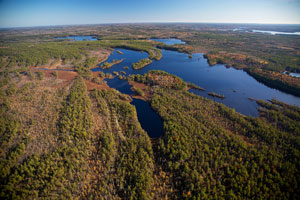 Pu’tlaqne’katik protects three disjunct parts of the Pleasant River watershed, in the interior of western Nova Scotia. Totalling about 3,000 hectares (ha), the area includes many waterways used by the Mi’kmaq for centuries. These lands are designated under the Wilderness Areas Protection Act.
Pu’tlaqne’katik protects three disjunct parts of the Pleasant River watershed, in the interior of western Nova Scotia. Totalling about 3,000 hectares (ha), the area includes many waterways used by the Mi’kmaq for centuries. These lands are designated under the Wilderness Areas Protection Act.
The name Pu’tlaqne’katik originates from a local Mi’kmaw elder’s vision of a lake called “Shaving Lake” or “Shingle Lake”.
This wilderness area is an “ecological hotspot”, or place of elevated importance for biodiversity, with a high concentration of rare and at-risk species. The woodlands consist primarily of imperfectly or poorly drained conifer forest. Soils are generally thin, with relatively low productivity. Aquatic habitats include slow moving river and streams (stillwaters), bogs, fens, shallow lakes and lakeshores. These features provide refuge for at-risk species, including Blandings turtle, ribbon snake, and several rare flora species, including golden crest and uncommon arctic-alpine plants.
Protection of these landscape features helps improve representation of the LaHave Drumlins Natural Landscape in Nova Scotia’s protected areas system.
Several parcels within the wilderness area were acquired for protection by the Nova Scotia Nature Trust and Ducks Unlimited.
Pu’tlaqne’katik is used for fishing, hunting, trapping, canoeing, camping, species-at-risk research, and other activities.
The road to the beach at the north side of Pleasant River Lake is open to vehicle access, as is Medlee Lane near the northeast end of Shingle Lake. A road corridor to a private parcel on Pleasant River Lake is not part of the wilderness area.
Three existing campsite leases in the wilderness area will be honoured under the Wilderness Areas Protection Act.
Legal protection of about 200 additional ha of Crown land along Route 325, between Shingle Lake and Seven Mile Lake, and of another 26 ha near Brookfield Mines will come into effect if overlapping mineral rights expire and no new rights are issued.

